Join JPI UE
Faq
FAQ
Please click here for the frequently asked questions we collected.
If you have an additional questions you are welcome to mail us at info@jpi-urbaneurope.eu
The EX-TRA project champions a playful, experimental approach to urban redesign, providing a low-cost, low-risk way to test ideas and collect feedback from citizens. This iterative process involves temporary interventions, citizen consultation, and adaptation, helping policymakers navigate urban transformation with more confidence and agility.
We spoke with Luca Bertolini, the project coordinator, to discuss how this experimental approach is reshaping our understanding of urban transportation and public space and aiding cities in maximising the potential of their streets and neighbourhoods.
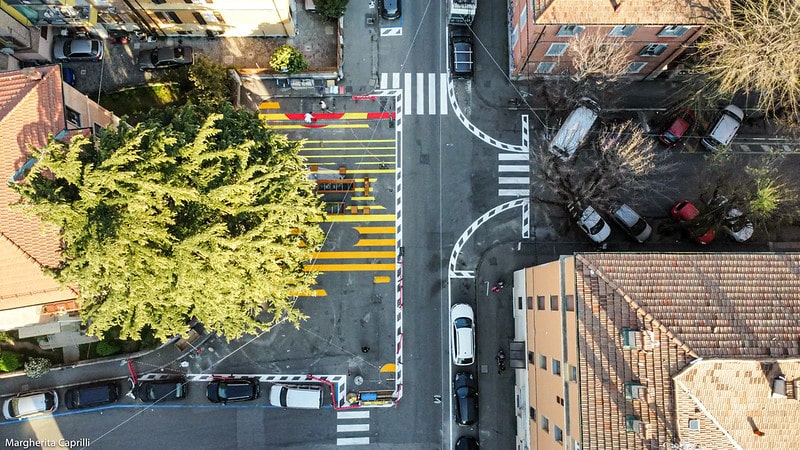
Photo drone area di intervento Procaccini. Photo by Margherita Caprilli for Fondazione Innovazione Urbana.
Envisioning the Post-car City
At the heart of EX-TRA is the concept of the “post-car city,” a city where accessibility is primarily provided by proximity, walking, cycling, or wheelchair use, and where there are ample alternative mobility options that reduce the need for car ownership and use. “We focus on street experiments, which explore different uses, forms, and regulations for city streets on a temporary basis to learn about the possibilities, but also the challenges that a transition to what we call a post-car city are,” Luca explains.
The project involves six cities – Ghent, Amsterdam, Munich, Bologna, Milan, and London – each at different stages of the transition process but united in their desire to make significant strides towards becoming post-car cities. Using the tools produced by EX-TRA, these cities experimented with temporary interventions to test new ideas, gather feedback from citizens, and learn valuable lessons about what works and what doesn’t in their specific contexts.
StreetECHO – Learning from the Streets
One of the key tools developed by EX-TRA is StreetECHO, a platform for supporting citizen engagement in street transformation. Consisting of an online survey, a data visualisation webtool and a detailed protocol for face-to-face community workshops, StreetECHO helps policymakers collect feedback from citizens, understand their needs and preferences, and involve them in the co-creation of street transformation.

Photo by Margherita Caprilli for Fondazione Innovazione Urbana.
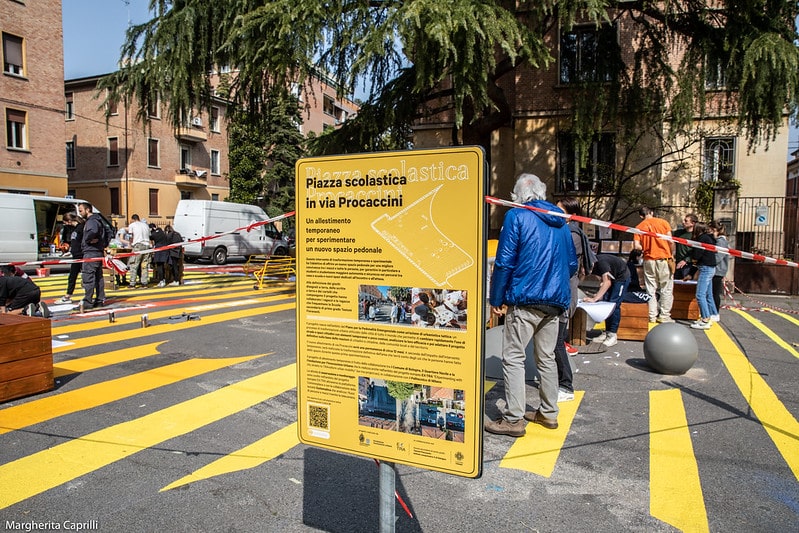
Photo by Margherita Caprilli for Fondazione Innovazione Urbana.
“It’s a tool that really helps to collect feedback from citizens, also understanding that these citizens are different,” Luca notes. StreetECHO is freely accessible globally and can provide valuable insights into how people perceive and interact with their urban environments.
StreetECHO was developed based on insights from the Commonplace survey platform, which was used during the EX-TRA project to engage citizens in evaluating street experiments in London, Munich, and Bologna. In London, for instance, it was applied to understand how citizens perceived the South Woodford Mobility Hub, a street experiment that combines seating, plants, cycle parking, a reserved space for an electric vehicle from a car club, and a public EV charging point.
The application of a community engagement mapping tool demonstrated its utility in providing insights such as the general positive reception to the Mobility Hub by users. Interestingly, those who had never used the Hub were significantly more likely to express dissatisfaction compared to active users. The consultation also showed that the Hub was primarily used for public and social activities, such as eating, drinking, relaxing, and socialising, rather than for transport or mobility.
These insights demonstrate the power of citizen engagement in shaping urban experimentation and creating public spaces that truly meet the needs and desires of the local community. This consultation process has been instrumental in shaping the development of the StreetECHO toolkit, which not only captures citizens’ perceptions and preferences but also empowers them to participate actively in the transformation of their streets.
Putting Pedestrians and Cyclists on the Map
Another of the great successes of the project was developing the Geo Open Accessibility Tool (GOAT). GOAT takes a data-driven approach to assessing the quality of accessibility by walking and cycling. Created by the Technical University of Munich team, GOAT is an interactive tool that allows policymakers and planning offices to explore how different interventions could improve accessibility in their cities and regions.
Built on the OpenStreetMap platform, GOAT enables users to assess the accessibility of everyday needs, such as grocery stores, schools, and healthcare facilities. The real magic happens when users start experimenting with different interventions, like closing a street to cars or adding a bike lane. GOAT instantly visualises the impact of these changes on overall accessibility, making it a powerful tool for data-driven decision-making.
“GOAT is the best tool we produced in terms of interactivity,” Luca explains. It’s equipped with a plethora of complex spatial data, including points of interest, buildings, population data, land use, environmental data, and various background maps. In addition, you can easily integrate your own data sets.
The tool has garnered so much interest during the project that it has become commercially available through the company Plan4Better. It is important to note that Street Echo and GOAT could create a powerful combination for understanding and improving urban accessibility. While Street Echo brings the human perspective through citizen engagement, GOAT provides a complementary data-driven perspective to back up decision-making. By using these tools in tandem, cities can create a more comprehensive picture of their accessibility challenges and opportunities, ultimately leading to more informed and effective interventions.
IAPI Puts Inclusivity at the Heart of Urban Experimentation
While experimentation undeniably drives innovation and adaptation in city planning, it is important that these efforts do not sideline inclusivity. Thankfully, EX-TRA did not neglect this important social responsibility in its work. It has produced an invaluable tool called the Inclusive Accessibility by Proximity Index (IAPI).
Developed by Politecnico di Milano, IAPI meticulously assesses how accessible essential services—like schools, healthcare, and grocery stores—are based on the walkability/bikeability conditions affecting various user groups, including pedestrians, impaired pedestrians and cyclists. By utilising a mix of open data, administrative records, and targeted surveys, IAPI constructs an intricate accessibility landscape for each area, visualised through colour-coded GIS maps that distinguish areas by levels of accessibility tailored to different groups.
Such detailed insights allow policymakers and urban planners to direct experimental efforts where they are most needed, ensuring that experiments in urban design and redesign are inclusive. IAPI exemplifies how tools can bridge the gap between cutting-edge urban experimentation and the fundamental necessity of inclusivity, ensuring that all citizens benefit from smarter, more responsive cities.
Exploring Future Mobility Scenarios
Another tool developed by EX-TRA is the Dashboard for Alternative Mobility Scenarios (D4AMS), an agent-based modelling platform that enables policymakers to explore radical future scenarios involving street closures, bike-sharing, and car-sharing. By simulating the interactions between agents representing people and their transportation choices, D4AMS helps cities understand the potential impacts of bold interventions and identify the most promising strategies for achieving their mobility goals.
“Suppose we close all the streets, or half of the streets, or we have car sharing everywhere. You can really explore things that you could never literally do with experiments because they’re too big for just experimentation,” Luca explains. In Ghent, for example, D4AMS was used to model the impact of a proposed bike-sharing system in combination with street closures. The results showed that while the interventions would improve accessibility and sustainability in some areas, they could also lead to increased car traffic in others – a valuable insight for policymakers seeking to balance the costs and benefits of urban mobility transformations.
Facilitating Learning and Collaboration
In order to help cities learn from each other’s experiences and navigate the complex challenges of transforming urban mobility, EX-TRA has also developed the Strategy for Change Workshop Protocol and the Conversation Starter Deck, two tools aimed at fostering knowledge sharing and the effective governance of street experiments, bringing policymakers with different perspectives and concerns together. The Strategy for Change Workshop Protocol is the result of several workshops given during the EX-TRA project. The goal is to allow policymakers to explore the different roles and positions they can adopt when implementing street experiments (for example, more top-down and hands-on, or a more facilitating role). During the first several implementations of this workshop, participants noted feeling ‘relieved’ after hearing that other cities are dealing with the same types of issues, like initial disapproval from users who fear being inconvenienced during the experiment. “We have some cities that have more experience with implementing street experiments and some that are just starting out. Bringing these people together and allowing them to learn from each other is an important aim and result of the Strategy for Change workshop,” Luca notes. The EX-TRA team implemented the Strategy for Change Workshop three times throughout the project with participants from Europe, the UK, and North America. Based on these experiences, the team developed the Workshop Protocol, including clear instructions for municipalities that would like to organise and replicate the workshop themselves.
The second tool is the Conversation Starter Deck, which is aimed at experiment organisers and policymakers from the municipality wishing to start the process of designing and implementing an experiment. Because street experiments involve many different departments within a municipality, the EX-TRA team developed the Conversation Starter Deck to guide local governments on this journey. Questions like “How can we garner political support?” and “Which permits do we need to arrange?” appear on each card with a short explanation on the back to allow for a fun and interactive way to discuss and plan for the implementation of street experiments.
Giving the Public What They Want
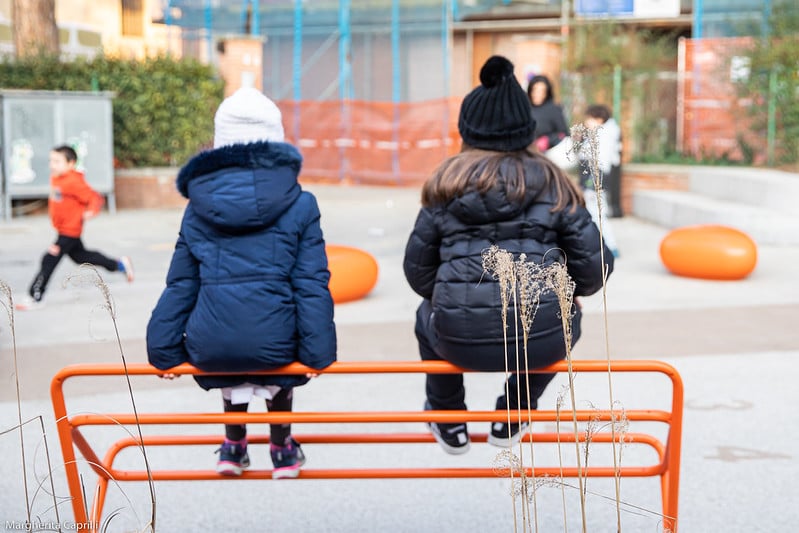
The EX-TRA school square experiment in Bologna – Piazza Tambroni Monitoraggio. Photo by Margherita Caprilli for Fondazione Innovazione Urbana.
When considering the overall impact of EX-TRA, it is important to note that experimentation often shows that people’s priorities may not be what we think they are. In Bologna, for instance, the project was involved in a school street experiment that transformed a parking lot into a vibrant square for children and parents. By involving the students directly, the city discovered that the most important aspect for the children was not just improved safety or mobility but the creation of an informal space where they could meet and interact with each other. This insight led to the design of a square featuring the word “hello” written in all the languages spoken by the school’s diverse student body – a powerful symbol of social interaction and respect. The experiment was so successful that the city decided to make it permanent and replicate the intervention in front of other schools.
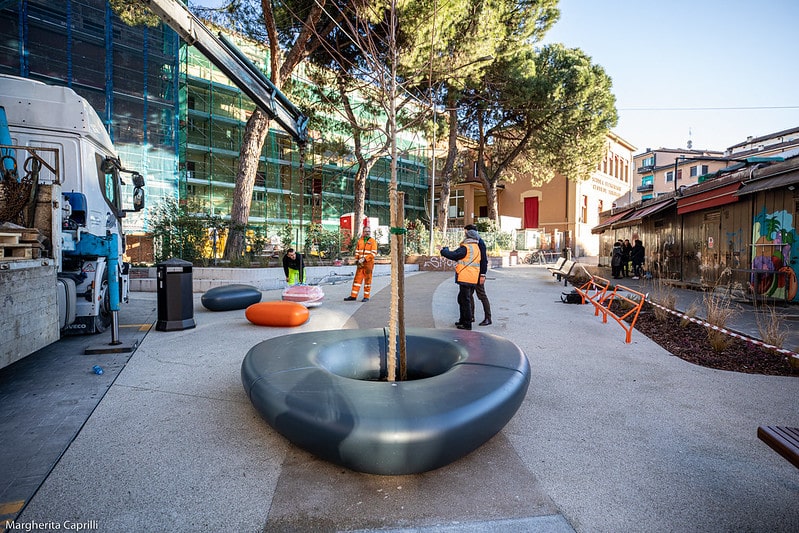
Piazza Tambroni Monitoraggio. Photo by Margherita Caprilli for Fondazione Innovazione Urbana.
“Our main aim is to enable learning,” Luca concludes, adding, “And of course, for things to happen, you need much more than just research.” With projects like EX-TRA leading the charge, cities can begin to imagine a future where streets are not just corridors for cars but vibrant public spaces that bring communities together and create a more sustainable, equitable, and joyful urban experience for all.
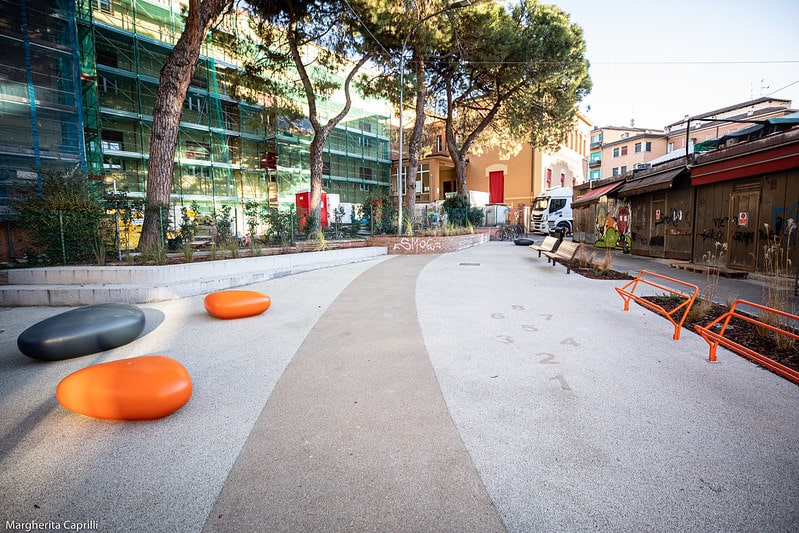
Piazza Tambroni Monitoraggio. Photo by Margherita Caprilli for Fondazione Innovazione Urbana.